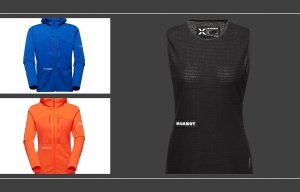
Awards for Mammut and Polartec
Fabric creates a more regular climate next to the skin, which in turn helps the wearer to stay cool.

15th May 2024
Innovation in Textiles
|
Pudsey, West Yorkshire, United Kingdom
The UK’s Hainsworth Protective Fabrics has recently been putting its Eco-Dry wildland fabric, combining flame-retardant meta-aramid fibres with Merino Wool and Lenzing FR, to the test.
When fighting wildfires, firefighter PPE needs to have very specific design requirements. Firefighters typically cover great stretches of open land while battling heat and flame, putting them at risk of overheating and exhaustion. In addition to being flame retardant, wildland PPE needs to be comfortable to wear for long stretches of physical activity and help the wearer maintain a consistent body temperature.
More than just being soft to the touch, wool has numerous natural properties that make it an optimum performance fibre. It is highly durable, retains its shape well and is naturally water-repellent and odour resistant while also having naturally fire retardant properties. Most importantly for firefighters, wool is excellent at wicking away moisture, with one of the highest water vapour adsorption levels of any textile fibre.
Moisture management is a crucial quality for wildland firefighting garments. If the fabric is effective at wicking away sweat, it helps to create a more regular climate next to the skin, which in turn helps the wearer to stay cool. Without moisture-wicking properties, a wildland firefighter’s PPE could cause them to overheat, putting themselves and others at risk.
Benefits
To demonstrate the benefits offered by wool/Lenzing FR, Hainsworth has tested Eco-Dry against a prototype wildland fabric made from a 100% meta-aramid blend.
Both were submitted to an accredited independent test house for RET testing to quantify moisture management and Eco-Dry was found to be 17% more breathable than the 100% meta-aramid blend.
Further testing was then carried out at James Heal in Halifax, using WickView equipment which tracks and records the real-time transfer of moisture through fabric, replicating how it will perform when being worn. This revealed that while Eco-Dry continued to demonstrate excellent wicking properties for a flame-retardant fabric, no moisture passed through the 100% meta-aramid blend at all.
This indicates that wildland PPE fabric made from a 100% meta-aramid blend will not let any sweat transfer through. However, with the inclusion of Merino Wool, perspiration is drawn away from the firefighter’s skin and through the fabric, which helps retain a manageable body temperature.
By selecting wildland PPE that incorporates Merino Wool fibre, fire services ensure their front-line crew are wearing kit that is truly tailored to meet the specific challenges of their role.

Business intelligence for the fibre, textiles and apparel industries: technologies, innovations, markets, investments, trade policy, sourcing, strategy...
Find out more